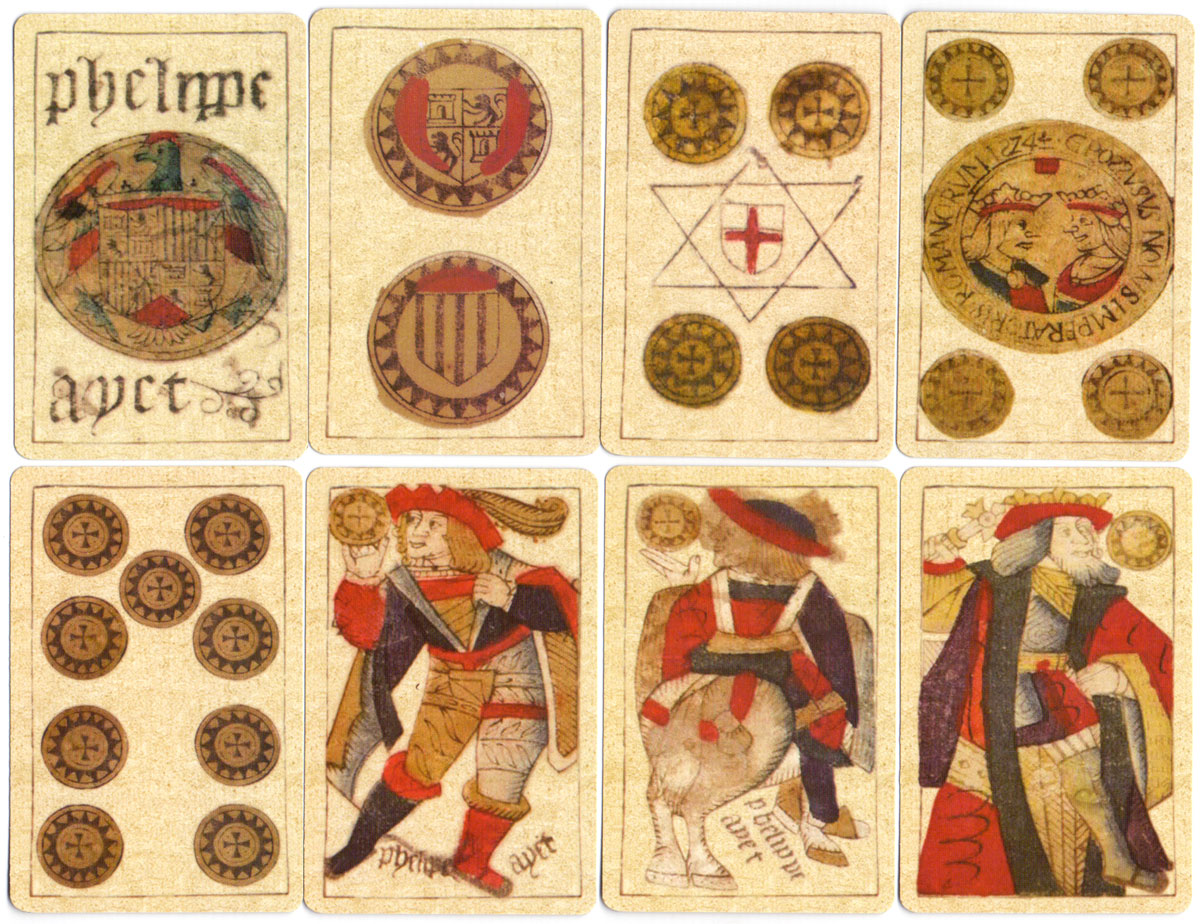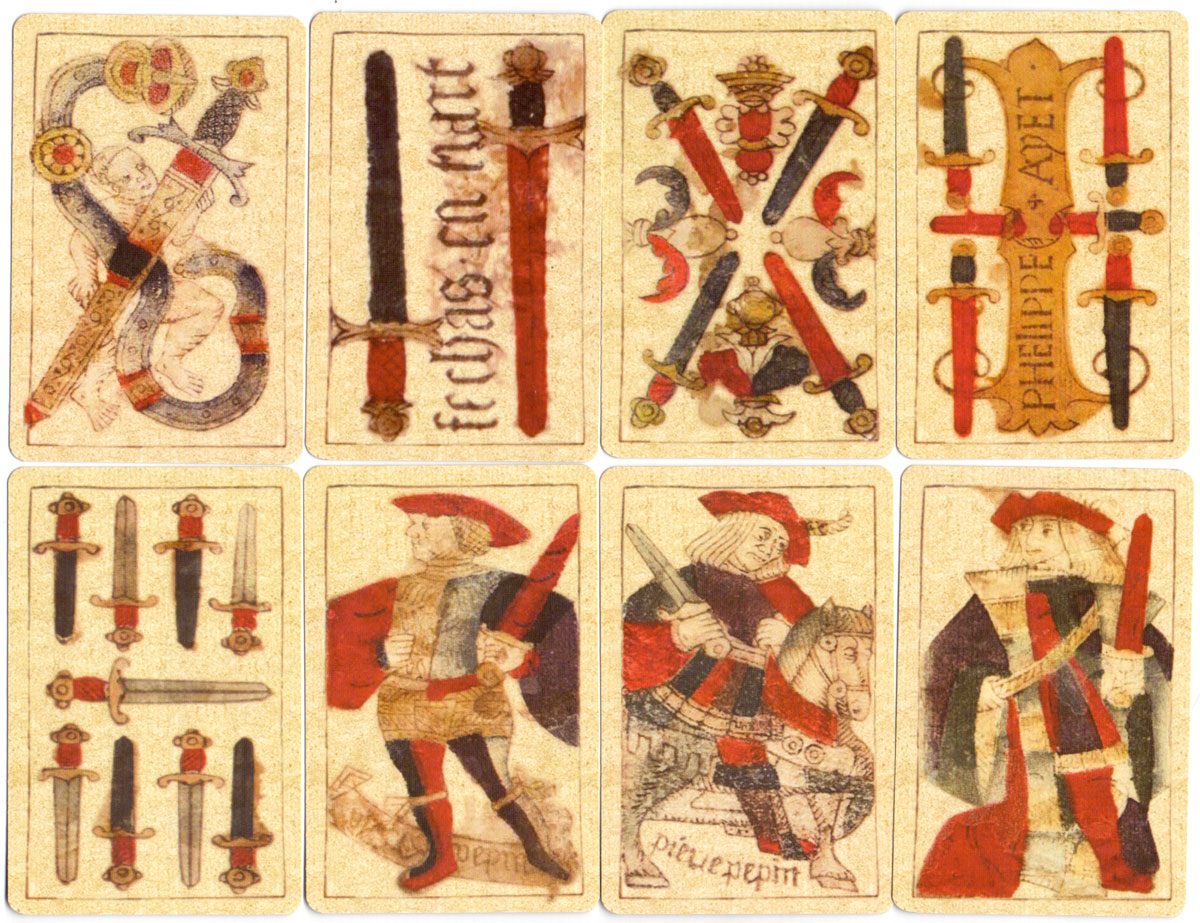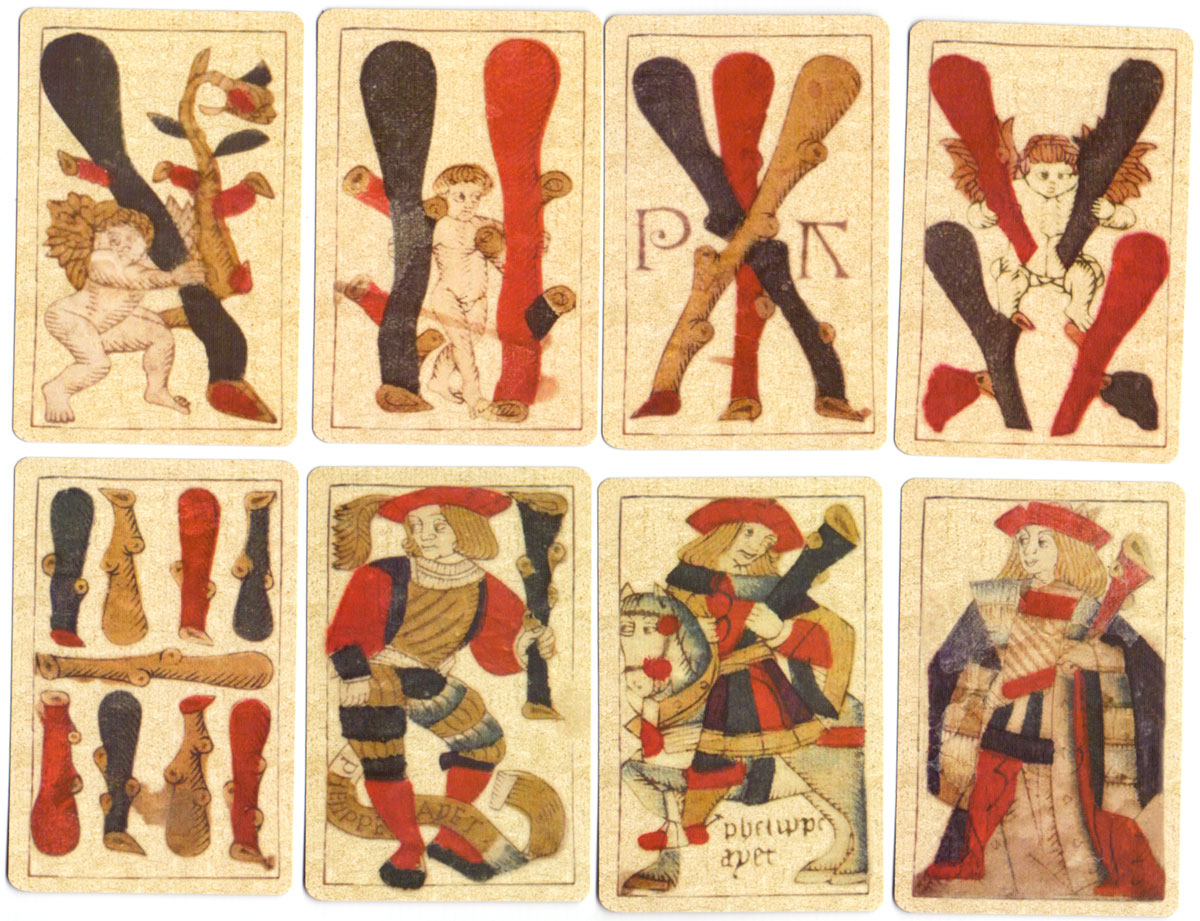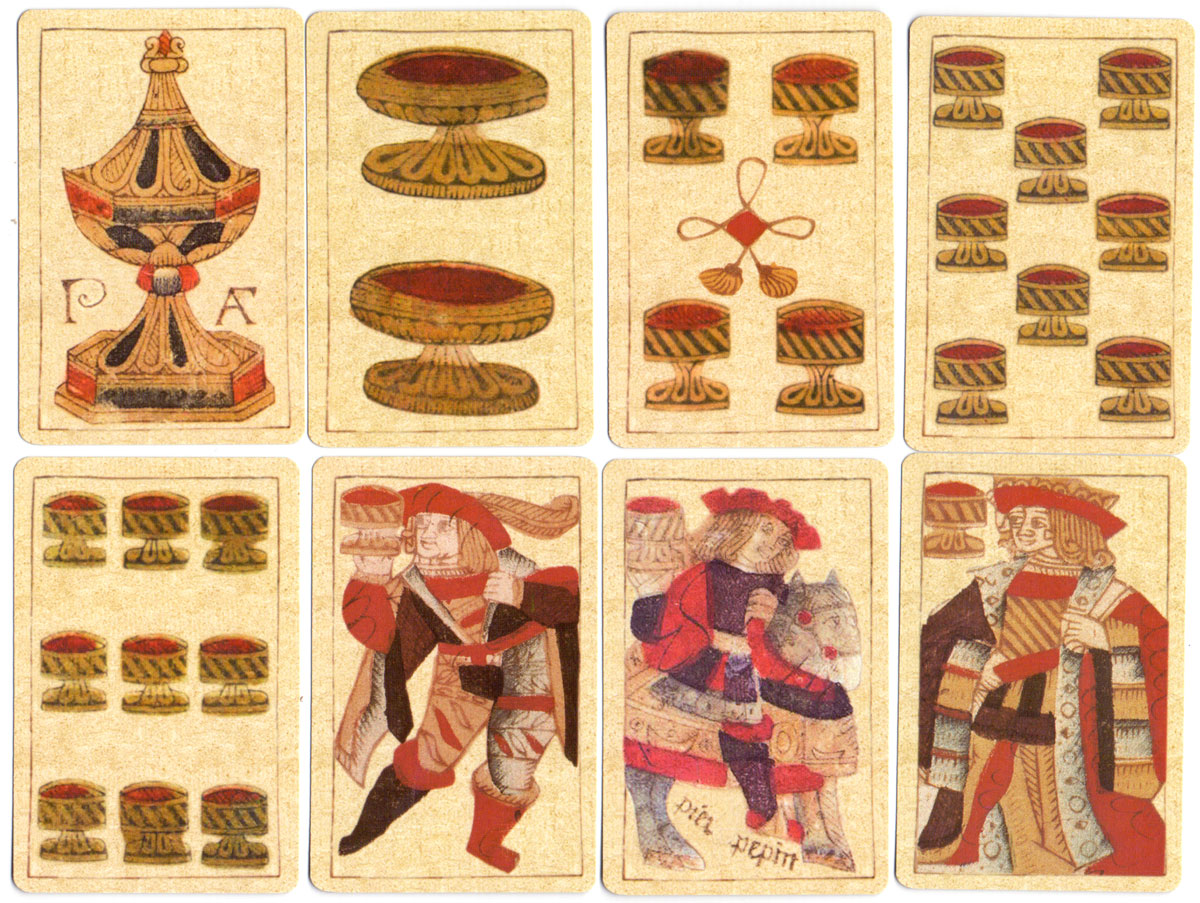Phelippe Ayet, 1574
49 assorted cards were found hidden in the lintel of a doorway, in an old building in Toledo, during demolition, and are now preserved in the the Museo de Santa Cruz de Toledo.
Facsimile of Archaic Spanish-suited playing cards.




Above: facsimile cards of archaic Spanish-suited pattern, printed from woodcuts by Phelippe Ayet and and Pierre Pepin, dated 1574 with the place of issue stated as Thiers on the two of swords. Phelippe Ayet was a card maker living in Valencia. Pierre Pepin was a French card maker who operated in Seville and who was known by Miguel Cervantes. A total of 49 assorted cards by these different makers were found hidden in the lintel of a doorway, in an old building in Toledo, during demolition, and are now preserved in the the Museo de Santa Cruz de Toledo. Size: 57 x 98 mms, reverse blank. Another similar pack has been discovered in Madrid by the same maker, who was recorded as residing in the Valencia region at that time. Cards from facsimile edition by Naipes Comas, 2002. The set includes 2 explanatory cards→
The archaic Franco-Spanish pattern was produced and used in both France and Spain and several of the court card postures have survived in other regional patterns. The king of coins brandishing an axe recurs in several former French regional patterns and survives today in the king of hearts (‘suicide king’) in modern poker packs. In the example illustrated below, the ace of coins carries the coat of arms of the Catholic Monarchs, as well as the double-headed eagle of the Habsburgs topped by the crown of the empire of Charles V.
Diego del Campo
Diego del Campo is believed to have been a Frenchman who travelled to Spain in the mid-16th century fleeing political and religious unrest. A number of card makers and other artisans migrated and settled in Spain, moving through cities like Logroño, Burgos, Valladolid and Segovia, before reaching Toledo, the capital of the Empire at the time, or Sevilla. These playing cards are not solely attributed to Diego del Campo, as Guillermo Moreo is also credited on several cards.

Above: 48-card Franco-Spanish pattern deck produced by Diego del Campo, Toledo, c.1550. The back pattern is a series of small, regular dots. © Museo de la Baraja de Madrid.
References
Lopez, Nacho: Descubierta la baraja más antigua del mundo, que fue fabricada en Castilla-La Mancha en 1540 in El Digital de Albacete 16 octubre, 2023►
Martín Carrillo, Alejandro: La baraja de cartas española más antigua del mundo se hizo en Toledo y data del 1540 in cadenaser.com 21/10/2023►
Pérez González, Alberto: Diego del Campo ¿El primer hombre en “hacer naipes” en España? in La Sota Nº53, Oct 2024, Asescoin, Madrid.
Denning, Trevor: The Playing-Cards of Spain, Cygnus Arts, London, 1996 - see p.46.
Anonymous uncut sheet dated 1587
On the three of clubs (first row second from the right) is the inscription F.T° that refers to Toledo. The same letters are repeated on the card with the 4 of chalices (second row fourth from the left) and on the next card at right the three of chalices is the year 1587. The profiles of the Catholic kings (Isabel and Ferdinand) on the five of coins and the coat of arms of Castilla and Leon and Aragon (partly trimmed from bottom) form the two of coins. The little naked figures are not seen in this example.

Above: on the 3 of clubs and 4 of cups are the initials F.T°. (Toledo), and the date 1587 appears on the 2 of cups. The 4 of coins bears a merchant's mark, the 2 has the arms of Leon and Castile, and on the 5 is the usual coin with two heads. Woodcut, hand coloured using stencils. © The Trustees of the British Museum • Museum number 1896,0501.1346►

By Simon Wintle
Member since February 01, 1996
I am the founder of The World of Playing Cards (est. 1996), a website dedicated to the history, artistry and cultural significance of playing cards and tarot. Over the years I have researched various areas of the subject, acquired and traded collections and contributed as a committee member of the IPCS and graphics editor of The Playing-Card journal. Having lived in Chile, England, Wales, and now Spain, these experiences have shaped my work and passion for playing cards. Amongst my achievements is producing a limited-edition replica of a 17th-century English pack using woodblocks and stencils—a labour of love. Today, the World of Playing Cards is a global collaborative project, with my son Adam serving as the technical driving force behind its development. His innovative efforts have helped shape the site into the thriving hub it is today. You are warmly invited to become a contributor and share your enthusiasm.
Related Articles

Saarberg 79
Saarberg mining pack for 1979, with designs by Fritz Ludwig Schmidt.

Ministère des Postes et Télécommunications
Famous figures connected with the French postal service, with designs by Henri Simoni.

Jeu Buffon
Illustrations of different birds from works by Buffon to celebrate the bicentenary of his death.

Pathé Marconi
Special promotion pack for French record company Pathé Marconi.

Pierre Varangot
Tracing the origins, legality and legacy of Pierre Varangot’s San Sebastián deck.

Archaic Spanish-suited pattern from Bayonne
Archaic Franco-Spanish pattern from Bayonne by a manufacturer with the initals M.V.

Caisse Mutuelle d'Assurance et de Prevoyance
Insurance propaganda pack for Caisse Mutuelle d'Assurance et de Prevoyance with humorous artwork by ...

Jeu Révolutionnaire
Court cards and aces from a French Revolutionary pack by Pinaut, Paris, c.1794.

French Revolutionary cards by Pinaut
Seven cards from a French Revolutionary pack by Pinaut featuring characters from classical antiquity...

Tarot de las Coscojas
Historical playing card design, tarot symbolism and an almost psychedelic medieval surrealism.

Tarot de Valverde de la Vera
A series of 24 surrealist engravings by Mexican artist Claudio Favier in which archetypal Tarot alle...

Never Mind the Belote
Limited edition Belote pack with designs by a collective of 24 street artists.

Sannois dans les étoiles
Celebrities and buildings associated with Sannois, a commune in the suburbs of Paris.

Le Globe Céleste
Views and plans of five international exhibitions held in Paris between 1855 and 1900.

Baraja de Juan Martín Zamorano
Deck inspired by El Pendón de los Zamorano, a military pennant dating from 1501, published by Priego...

Le Journal de Mickey
Perforated sheet of cards with Disney characters issued with the magazine Le Journal de Mickey.
Most Popular
Our top articles from the past 28 days

